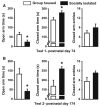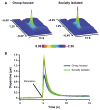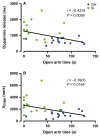Enduring increases in anxiety-like behavior and rapid nucleus accumbens dopamine signaling in socially isolated rats
- PMID: 23294165
- PMCID: PMC3746484
- DOI: 10.1111/ejn.12113
Enduring increases in anxiety-like behavior and rapid nucleus accumbens dopamine signaling in socially isolated rats
Abstract
Social isolation (SI) rearing, a model of early life stress, results in profound behavioral alterations, including increased anxiety-like behavior, impaired sensorimotor gating and increased self-administration of addictive substances. These changes are accompanied by alterations in mesolimbic dopamine function, such as increased dopamine and metabolite tissue content, increased dopamine responses to cues and psychostimulants, and increased dopamine neuron burst firing. Using voltammetric techniques, we examined the effects of SI rearing on dopamine transporter activity, vesicular release and dopamine D2-type autoreceptor activity in the nucleus accumbens core. Long-Evans rats were housed in group (GH; 4/cage) or SI (1/cage) conditions from weaning into early adulthood [postnatal day (PD) 28-77]. After this initial housing period, rats were assessed on the elevated plus-maze for an anxiety-like phenotype, and then slice voltammetry experiments were performed. To study the enduring effects of SI rearing on anxiety-like behavior and dopamine terminal function, another cohort of similarly reared rats was isolated for an additional 4 months (until PD 174) and then tested. Our findings demonstrate that SI rearing results in lasting increases in anxiety-like behavior, dopamine release and dopamine transporter activity, but not D2 activity. Interestingly, GH-reared rats that were isolated as adults did not develop the anxiety-like behavior or dopamine changes seen in SI-reared rats. Together, our data suggest that early life stress results in an anxiety-like phenotype, with lasting increases in dopamine terminal function.
© 2013 Federation of European Neuroscience Societies and Blackwell Publishing Ltd.
Figures






Similar articles
-
Social isolation rearing increases nucleus accumbens dopamine and norepinephrine responses to acute ethanol in adulthood.Alcohol Clin Exp Res. 2014 Nov;38(11):2770-9. doi: 10.1111/acer.12555. Alcohol Clin Exp Res. 2014. PMID: 25421514 Free PMC article.
-
Social isolation rearing increases dopamine uptake and psychostimulant potency in the striatum.Neuropharmacology. 2016 Feb;101:471-9. doi: 10.1016/j.neuropharm.2015.10.025. Epub 2015 Oct 23. Neuropharmacology. 2016. PMID: 26525189 Free PMC article.
-
Adolescent rearing conditions influence the relationship between initial anxiety-like behavior and ethanol drinking in male Long Evans rats.Alcohol Clin Exp Res. 2013 Jan;37 Suppl 1(Suppl 1):E394-403. doi: 10.1111/j.1530-0277.2012.01926.x. Epub 2012 Aug 24. Alcohol Clin Exp Res. 2013. PMID: 22924742 Free PMC article.
-
Early-Life Social Isolation Stress Increases Kappa Opioid Receptor Responsiveness and Downregulates the Dopamine System.Neuropsychopharmacology. 2016 Aug;41(9):2263-74. doi: 10.1038/npp.2016.21. Epub 2016 Feb 10. Neuropsychopharmacology. 2016. PMID: 26860203 Free PMC article.
-
Dopamine depletion of the nucleus accumbens reverses isolation-induced deficits in prepulse inhibition in rats.Neuroscience. 2003;119(1):233-40. doi: 10.1016/s0306-4522(03)00122-2. Neuroscience. 2003. PMID: 12763084
Cited by
-
Therapeutic potential of diosmin, a citrus flavonoid against arsenic-induced neurotoxicity via suppression of NOX 4 and its subunits.Indian J Pharmacol. 2021 Mar-Apr;53(2):132-142. doi: 10.4103/ijp.IJP_837_19. Indian J Pharmacol. 2021. PMID: 34100397 Free PMC article.
-
Early Life Stress, Nicotinic Acetylcholine Receptors and Alcohol Use Disorders.Brain Sci. 2015 Jun 30;5(3):258-74. doi: 10.3390/brainsci5030258. Brain Sci. 2015. PMID: 26136145 Free PMC article. Review.
-
Adolescent Social Isolation as a Model of Heightened Vulnerability to Comorbid Alcoholism and Anxiety Disorders.Alcohol Clin Exp Res. 2016 Jun;40(6):1202-14. doi: 10.1111/acer.13075. Epub 2016 May 7. Alcohol Clin Exp Res. 2016. PMID: 27154240 Free PMC article. Review.
-
The effects of rearing environment and chronic methylphenidate administration on behavior and dopamine receptors in adolescent rats.Brain Res. 2013 Aug 21;1527:67-78. doi: 10.1016/j.brainres.2013.06.021. Epub 2013 Jun 24. Brain Res. 2013. PMID: 23806775 Free PMC article.
-
Effects of cocaine combined with a social cue on conditioned place preference and nucleus accumbens monoamines after isolation rearing in rats.Psychopharmacology (Berl). 2014 Aug;231(15):3041-53. doi: 10.1007/s00213-014-3470-0. Epub 2014 Feb 20. Psychopharmacology (Berl). 2014. PMID: 24553577 Free PMC article.
References
-
- Abercrombie ED, Keefe KA, DiFrischia DS, Zigmond MJ. Differential effect of stress on in vivo dopamine release in striatum, nucleus accumbens, and medial frontal cortex. J Neurochem. 1989;52:1655–1658. - PubMed
-
- Angulo JA, McEwen BS. Molecular aspects of neuropeptide regulation and function in the corpus striatum and nucleus-accumbens. Brain Res Rev. 1994;19:1–28. - PubMed
-
- Bananej M, Karimi-Sori A, Zarrindast MR, Ahmadi S. D1 and D2 dopaminergic systems in the rat basolateral amygdala are involved in anxiogenic-like effects induced by histamine. J Psychopharmacol. 2012;26:564–574. - PubMed
-
- Barr AM, Young CE, Sawada K, Trimble WS, Phillips AG, Honer WG. Abnormalities of presynaptic protein CDCrel-1 in striatum of rats reared in social isolation: relevance to neural connectivity in schizophrenia. Eur J Neurosci. 2004;20:303–307. - PubMed
-
- Bartoszyk GD. Anxiolytic effects of dopamine receptor ligands: I. Involvement of dopamine autoreceptors. Life Sci. 1998;62:649–663. - PubMed
Publication types
MeSH terms
Substances
Grants and funding
LinkOut - more resources
Full Text Sources
Other Literature Sources
Medical

